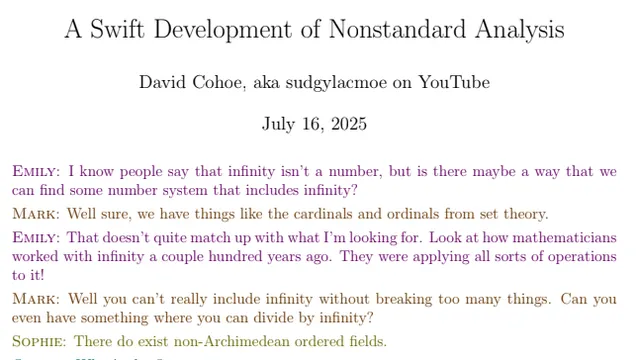A Swift Development of Nonstandard Analysis
Audience: undergraduategraduate
Tags: analysis
This document is a development of nonstandard analysis. However, instead of being written in a traditional, expositional format, the development is done through a discussion involving several characters who are trying to figure out the topic for themselves. While I do care about the topic and hope you learn a lot through what I wrote, my primary purpose in writing this is to highlight this conversational approach to mathematical writing.
Analytics
Comments
The format of this article is quite novel, to the advantage of the submission. It’s reminiscent of the Socratic method crossed with a screenplay; I could see a version of this being acted out in a classroom setting or holding the interest of certain students much more readily than a standard textbook explaination.
The author has a very interesting exposition style, which could help retain the attention of a student. It’s not 100% clear it works well, but it definitely works well enough to investigate further.
I love the discussion format, and as you state in your conclusory introduction, it does a far better job at maintaining attention. Even in the drier parts of the conversation, I found myself inspired to follow along because I enjoyed keeping track of the personalities of each of the participants. The main gripe I have with this is that there were some times where I felt like a video medium would help, even if just to keep the important talking points on screen while the conversation occurs.
I like how this article explains the definitions of abstract concepts in simple enough ways for the for the context they are a part of. The pacing is great for those who haven’t thought deeply of number systems with infinity before.
First off, for the purposes of this competition, the article is way too long, so I’ll have to deduct some points for that. It’s 31 pages long, so I didn’t have the time to read all of it thoroughly, and I’m gonna assume most judges didn’t have the time either. Maybe chopping it up into multiple sections and chapters would’ve helped here.
I do very much appreciate the writing style and flow. The conversation between six different speakers feels like a more natural and organic way of discovering new mathematical insights, compared to a stoic run-of-the-mill mathematical paper. Due to this organic flow, the article did feel a lot shorter than 31 pages of a dense math-filled paper would normally appear to be, although I feel it’s still too long.
I also appreciate the color-coding, every speaker seems to have their own color, making the flow of conversation much easier to follow.
The article also has a great sense of humor, I chuckled at the “llama” joke. It also seems nicely self-contained, I didn’t really have to look up too much beyond the article itself to be able to understand it.
This was a great episode of friends who love to play math. It reminded me of Nicolas Bourbaki. Would you try turning this episode into a podcast, and also add more content? The Ranking score is from an average of these individual scores, good luck: Motivation: 9 Clarity: 7.1 Novelty: 6.8 Memorability: 7
I’m not convinced a conversation in text form is an improvement over the standard theorem proof format. It may work as you originally intended, as a video. The advantage of text is it is easy to skip parts that are not relevant to what you want to know or you already know provided you can identify where those sections start and stop. I think your conversation text makes it harder to identify where topics change.
Cool format. To me, the names were a bit confusing to keep track of. Emily asked some unanswered questions which leaves me with a sense of unfinished dialog. In the section on compactness, I found myself wishing for diagrams.
I enjoy the motif of platonic dialogue in this.
